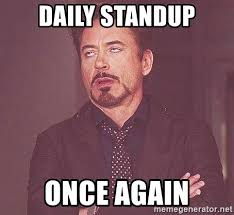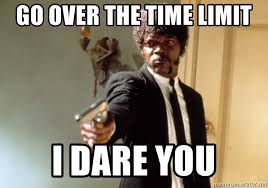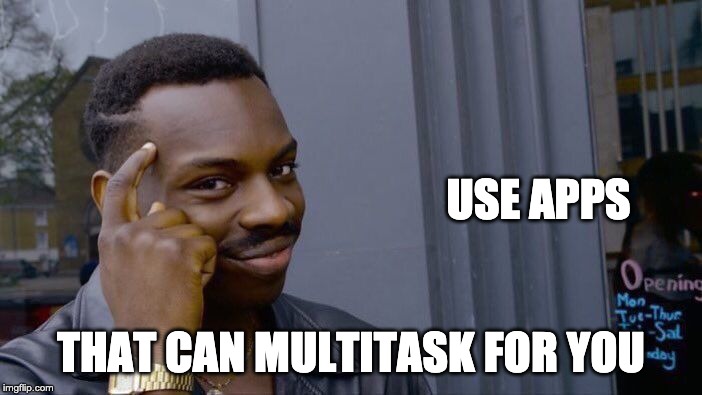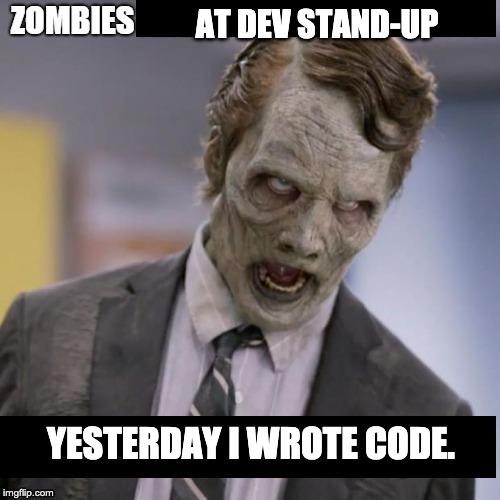
Once loved by agile teams, the daily stand-up meeting has really been taking heat the last couple of years. Given the commotion from outside teams, we decided to examine our own daily stand-up ritual. Was it still serving us? Or had we become trapped in a monotonous SCRUM cycle, unable to see time-wasting, zombifying “Blah Blah Blah. No blockers. Done” before our very eyes? Spooky. Before I get into my team’s experience, I’ll dive into what stand-up is and identify some of the common complaints. Then I’ll give some tips on resurrecting a stand-up that has lost its luster.
What Is Stand-Up?
The daily stand-up, a.k.a. scrum meeting, is a brief meeting performed by agile teams. It typically involves physically standing up and having each team member answer three questions: What did you do yesterday? What do you plan to do today? What are any “blockers” you are experiencing or you foresee that could impede your ability to meet your goals? The focus of these meetings is productivity and efficiency, and they typically last 15 minutes or less.
Why So Much Hate?
Stand-up sounds simple, clean, and brief, so why has it received so much bad press lately? Many argue that the daily stand-up is outdated, and some agile teams have abandoned the practice altogether. This is my summation of common complaints:
- Meetings drag on too long. Though stand-up meetings are intended to be brief, in practice, they can last long past 15 minutes, as sub-teams discuss in-depth details, some over-sharing team members wax on about irrelevant information, and teams’ sizes grow beyond 10 or so members. Time spent in these lengthy meetings disrupts the workflow and keeps you from doing your important tasks.

- It feels like a pointless waste of time. On the flipside of the over-sharers are the under-sharers. Some team members are so brief during stand-up to the point of irrelevance—”Yesterday, I did stuff. Today, I will also do stuff. Done!” The exchanges during stand-up no longer mean anything to the rest of the team, and while brief, the stand-up does nothing to improve productivity.

- It’s a challenge to get an entire team prepared and in one place at the same time to do an efficient stand-up. Some teams waste additional time standing around waiting for everyone to get up and join the meeting. And among the over-sharers and under-sharers are the under-preparers, who forgot what they did yesterday and aren’t sure what they’ll do today, but darn it, we’ll wait for them to figure it out so they can answer their three questions because that’s what it says in the scrum manifesto.

Our Thoughts on Stand-Up
Given the complaints addressed above, it’s not surprising to see popular headlines like “Stop the daily stand-up meeting” or “the daily stand-up is an anti-pattern.” During retrospective, we decided to float the idea of retiring our stand-up—not with the intention of actually dismantling the daily ritual, but more as a thought experiment. What would life be like without stand-up? What would we miss? What would we gain?
One by one, we gave our thoughts on stand-up. And from the majority, the sentiment was mostly positive. Here are the highlights of our favorite aspects of stand-up.
Information Sharing
Beyond answering the “three golden questions of stand-up,” the brief meeting is also a time when tidbits of general knowledge are shared among team members. In our stand-up, it’s common to hear, “Yesterday, I learned this,” or “I started trying this new tool or practice.” These pieces of information might have otherwise trickled throughout the team in Slack chatter or over lunch, but stand-up is a nice time to share quick tips, when the whole team is present and listening. Some might argue that this is anti-pattern, but for us, this type of sharing helps stand-up be more human, keeps us more engaged, and adds more value beyond the basic function of stand-up.
Onboarding New Members
Stand-up is especially helpful for onboarding new team members. As we all go around the room and discuss our accomplishments from yesterday and goals for today, it gives new members an inside look at other projects and provides some context for what others are working on. As we routinely share our day-to-day, new members quickly become integrated into the team. Right now, we’re hosting junior developer interns from a local code school, Epicodus. When they join our stand-up, they are able to see an abridged version of a day in the life of a software developer and how more senior software developers solve complex problems. This simple daily interaction adds an immense amount of value to their internship experience.
Celebrating & Venting
We use stand-up as a time to sing the highs and lows of software development. It’s important to celebrate wins, and stand-up is a great time to celebrate as a team before the little wins from yesterday fade into memory. Similarly, stand-up is a valid space to vent about problems as they arise. Sharing sentiments daily, in a group setting, makes sure that issues get addressed quickly, rather than having to wait for the next retrospective (which is when we more formally celebrate wins and discuss problems). Though we try to avoid taking time during stand-up to discuss solutions to these problems, bringing them up can be cathartic, and individuals or sub-teams can organize to formulate solutions outside of the stand-up if necessary.
Routine
Among the other benefits listed above, one of my favorite aspects of stand-up is its routine nature. You can always count on stand-up. It’s the ritual start of the day, though work and planning usually begin a little before stand-up. When preparing for stand-up, I have to be intentional and organized about how I plan my day and reflect on my goals and results from yesterday. Without this kind of organization and reflection, each day would seem like the same endless stream of completing tickets, nebulous and monotonous. But with stand-up, I focus on what made yesterday unique and how today will build on those results.
Though we mainly had positive remarks about stand-up, we also brought up some room for improvement. Some team members pointed out that it can be easy to space out when someone starts talking about granular details that aren’t helpful or interesting to others. Additionally, using project-specific jargon (such as specific Jira issue numbers) prevents other team members from understanding the full context of what is being discussed and therefore has less value.This feedback gave us an opportunity to hone our stand-up skills as a team, trim the parts that aren’t helpful, and focus on things that are.
Tips for Making the Most out of Stand-Up
Time Limits
A key part of a successful stand-up is maintaining its brevity. For our 8 person team, 10-15 minutes is the sweet spot. Depending on the size of your team and the nature of your work, yours might be longer or shorter. Find the right time limit that works for you, and practice hitting it. The scrum manager can help enforce the time in the beginning, but eventually, it will start feeling more natural. Physically standing up (if you’re physically able to) is one trick to keeping stand-up brief. Psychologically, standing up can encourage us to be more focused and to the point. When we sit around together, it’s more natural to start chit-chatting and extend the length of what should be a very brief meeting.

Create a Routine
Maintaining a solid stand-up practice requires creating a routine that everyone can and will stick to. If time is wasted on a daily basis, waiting around for someone to join, it defeats the purpose of the efficiency and productivity focus of the stand-up. Some form of mutual understanding (or maybe even enforcement) will be necessary in the beginning to encourage team members to join the meeting in a timely manner.
It’s also important to select a time that works well for everyone. Without this, a routine will be difficult to adopt. For example, we have our stand-up at 10:15 a.m. every morning. For us, a 9:30 a.m. stand-up wouldn’t work because some of us have early morning meetings, kids to drop off at school, or unpredictable commutes. Other teams might find it better to do their stand-up at 8 a.m. or 12 p.m. Try out different times, calibrate a time that works well for your team, and encourage everyone to build a routine around it.
Having a back-up plan is also essential. In a perfect world, we would all be present at 10:15 a.m. on the dot every single morning. That’s the goal, but reality works differently. Thankfully, we have a contingency plan. If anyone is running late or not going to be present, they announce this as early as possible, so we can decide to either start without them, have them join virtually, or push stand-up back if necessary. Your back-up plan might look different than ours, but it’s important to have one to minimize any breakups to the routine.
Use the Right Tools
Choosing the right tools can help streamline your stand-up routine. I use Shoutbase, a convenient time tracking app, which helps with stand-up in three key ways. First, (you guessed it) Shoutbase keeps track of how much time my team spends on stand-up. Each day, we're able to see how long stand-up takes and evaluate if we met our benchmark. We can also get a report to see how our stand-up has progressed over time. Second, I use the description field of Shoutbase time records to capture details about what I'm working on. The next morning, I have a catalog of what I did the day before, so I can easily give a report during stand-up. Third, Shoutbase allows teams to set goals for the day, week, month, or year. It's easy to see if our stand-up goals have been met or exceeded, and it gives us data to bring up during retrospective if necessary. I like using tools that can multitask, and Shoutbase is definitely one of them. Other tools, such as Notion and Trello, are great for keeping track of progress on tasks, and you can always use a classic stopwatch to time your stand-up.

Clearly Define Goals & Standards
The basic function of stand-up is clear: communicate your goals for today, progress from yesterday, and forthcoming blockers. But as discussed earlier, stand-up can be more than that. Our goals also include: sharing useful tips, celebrating wins, highlighting problems, expressing feelings, and facilitating cross-project cooperation. We have a running document defining the goals of stand-up and also the basic standards of procedure, so everyone is on the same page. If you don’t have a document like this, I encourage you to create one to keep your stand-up running smoothly.
Iterate & Improve
Defining goals and procedural standards doesn’t mean your stand-up practices are set in stone. In fact, you should routinely interrogate your practice and make sure it’s still serving your team. Bringing up stand-up during a team retrospective like we did is an excellent way to get everyone's input. Work together to create a stand-up that optimizes the way your team discusses and meets goals.
Conclusion
Some teams huddle around the campfire and whisper horror stories about a monstrous waste of time...stand-up! Not us. Over the years, we’ve fine-tuned our stand-up routine to serve us. Focusing on brevity as well as meaningfulness will help you make the most out of stand-up. Next time you do stand-up, think twice about responding with a zombie answer. Try to provide something of value to the rest of the team and most importantly, don’t ghost!
